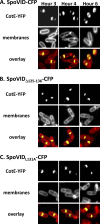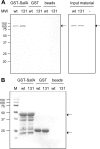Physical interaction between coat morphogenetic proteins SpoVID and CotE is necessary for spore encasement in Bacillus subtilis
- PMID: 22773792
- PMCID: PMC3430338
- DOI: 10.1128/JB.00914-12
Physical interaction between coat morphogenetic proteins SpoVID and CotE is necessary for spore encasement in Bacillus subtilis
Abstract
Endospore formation by Bacillus subtilis is a complex and dynamic process. One of the major challenges of sporulation is the assembly of a protective, multilayered, proteinaceous spore coat, composed of at least 70 different proteins. Spore coat formation can be divided into two distinct stages. The first is the recruitment of proteins to the spore surface, dependent on the morphogenetic protein SpoIVA. The second step, known as encasement, involves the migration of the coat proteins around the circumference of the spore in successive waves, a process dependent on the morphogenetic protein SpoVID and the transcriptional regulation of individual coat genes. We provide genetic and biochemical evidence supporting the hypothesis that SpoVID promotes encasement of the spore by establishing direct protein-protein interactions with other coat morphogenetic proteins. It was previously demonstrated that SpoVID directly interacts with SpoIVA and the inner coat morphogenetic protein, SafA. Here, we show by yeast two-hybrid and pulldown assays that SpoVID also interacts directly with the outer coat morphogenetic protein, CotE. Furthermore, by mutational analysis, we identified a specific residue in the N-terminal domain of SpoVID that is essential for the interaction with CotE but dispensable for the interaction with SafA. We propose an updated model of coat assembly and spore encasement that incorporates several physical interactions between the principal coat morphogenetic proteins.
Figures






Similar articles
-
A LysM Domain Intervenes in Sequential Protein-Protein and Protein-Peptidoglycan Interactions Important for Spore Coat Assembly in Bacillus subtilis.J Bacteriol. 2019 Jan 28;201(4):e00642-18. doi: 10.1128/JB.00642-18. Print 2019 Feb 15. J Bacteriol. 2019. PMID: 30455281 Free PMC article.
-
SpoVID guides SafA to the spore coat in Bacillus subtilis.J Bacteriol. 2001 May;183(10):3041-9. doi: 10.1128/JB.183.10.3041-3049.2001. J Bacteriol. 2001. PMID: 11325931 Free PMC article.
-
SpoVID functions as a non-competitive hub that connects the modules for assembly of the inner and outer spore coat layers in Bacillus subtilis.Mol Microbiol. 2018 Nov;110(4):576-595. doi: 10.1111/mmi.14116. Epub 2018 Oct 18. Mol Microbiol. 2018. PMID: 30168214 Free PMC article.
-
The Bacillus subtilis endospore: assembly and functions of the multilayered coat.Nat Rev Microbiol. 2013 Jan;11(1):33-44. doi: 10.1038/nrmicro2921. Epub 2012 Dec 3. Nat Rev Microbiol. 2013. PMID: 23202530 Free PMC article. Review.
-
Assembly and genetics of spore protective structures.Cell Mol Life Sci. 2002 Mar;59(3):434-44. doi: 10.1007/s00018-002-8436-4. Cell Mol Life Sci. 2002. PMID: 11964122 Free PMC article. Review.
Cited by
-
The Morphogenetic Protein CotE Positions Exosporium Proteins CotY and ExsY during Sporulation of Bacillus cereus.mSphere. 2021 Apr 21;6(2):e00007-21. doi: 10.1128/mSphere.00007-21. mSphere. 2021. PMID: 33883264 Free PMC article.
-
Architecture and assembly of the Bacillus subtilis spore coat.PLoS One. 2014 Sep 26;9(9):e108560. doi: 10.1371/journal.pone.0108560. eCollection 2014. PLoS One. 2014. PMID: 25259857 Free PMC article.
-
Bacterial developmental checkpoint that directly monitors cell surface morphogenesis.Dev Cell. 2022 Feb 7;57(3):344-360.e6. doi: 10.1016/j.devcel.2021.12.021. Epub 2022 Jan 21. Dev Cell. 2022. PMID: 35065768 Free PMC article.
-
The Conserved Spore Coat Protein SpoVM Is Largely Dispensable in Clostridium difficile Spore Formation.mSphere. 2017 Sep 20;2(5):e00315-17. doi: 10.1128/mSphere.00315-17. eCollection 2017 Sep-Oct. mSphere. 2017. PMID: 28959733 Free PMC article.
-
A dynamic, ring-forming MucB / RseB-like protein influences spore shape in Bacillus subtilis.PLoS Genet. 2020 Dec 14;16(12):e1009246. doi: 10.1371/journal.pgen.1009246. eCollection 2020 Dec. PLoS Genet. 2020. PMID: 33315869 Free PMC article.
References
-
- Boland FM, Atrih A, Chirakkal H, Foster SJ, Moir A. 2000. Complete spore-cortex hydrolysis during germination of Bacillus subtilis 168 requires SleB and YpeB. Microbiology 146:57–64 - PubMed
Publication types
MeSH terms
Substances
Grants and funding
LinkOut - more resources
Full Text Sources
Molecular Biology Databases

